V694 Mon: A Recent Event of Mass Transfer in the Dynamical Mode
Abstract
1. Introduction
2. Observations and Methods
3. Results
4. Discussion
5. Conclusions
Author Contributions
Funding
Data Availability Statement
Acknowledgments
Conflicts of Interest
Appendix A
| Atom/ Ion | Obs. λ (Å) | Cat. λ (Å) | EW (Å) | Data Base | Remarks |
|---|---|---|---|---|---|
| La II | 4429.89 | 4429.90 | −0.07 | Co93 | 4429.90 |
| Zr II | 4440.45 | 4440.45 | −0.03 | Co93 | |
| C IV | 4441.78 | 4441.74 | −0.03 | NIST | ? |
| Ho I | 4444.62 | 4444.63 | −0.03 | NIST | |
| Nd II | 4446.38 | 4446.387 | −0.01 | NIST | 4446.37 weak |
| Ce II | 4449.33 | 4449.336 | −0.05 | Co93 | 4449.33 |
| Nd II | 4451.57 | 4451.566 | −0.02 | Co93 | |
| Zr II | 4454.79 | 4454.80 | −0.05 | Co93 | |
| Zr II | 4457.45 | 4457.42 | −0.02 | Co93 | |
| Zr II | 4461.25 | 4461.22 | −0.02 | Co93 | |
| Nd II | 4462.96 | 4462.985 | −0.01 | Co93 | 4462.90 weak |
| Ti II | 4469.17 | 4469.16 | −0.03 | Co93 | |
| Fe II | 4472.95 | 4472.921 | −0.01 | Co93 | |
| Ce II | 4479.36 | 4479.35 | −0.03 | Co93 | 4479.32 blend |
| Ce II | 4486.89 | 4486.909 | −0.04 | Co93 | 4486.86 |
| Ti II | 4493.52 | 4493.523 | −0.03 | NIST | |
| Zr II | 4494.44 | 4494.41 | −0.03 | Co93 | 4494.47 |
| Zr II | 4495.41 | 4495.44 | −0.02 | Co93 | |
| Zr II | 4497.00 | 4496.96 | −0.04 | Co93 | 4497.04 abs PCyg |
| V II | 4518.36 | 4518.38 | −0.04 | Co93 | 4518.19 abs PCyg |
| La II | 4526.11 | 4526.12 | −0.03 | NIST | 4526.06 |
| Ce II | 4527.34 | 4527.348 | −0.05 | Co93 | 4527.30 |
| V II | 4528.53 | 4528.51 | −0.04 | Co93 | blend |
| Cr I | 4529.53 | 4529.50 | −0.03 | NIST | PCyg? |
| Ce II | 4539.75 | 4539.755 | −0.06 | NIST | 4539.72 |
| Ti II | 4544.04 | 4544.009 | −0.02 | Co93 | 4543.97 abs PCyg |
| Ti II | 4545.15 | 4545.144 | −0.04 | Co93 | |
| Ce II | 4551.27 | 4551.297 | −0.03 | Co93 | 4551.24 |
| Ti II | 4552.32 | 4552.289 | −0.04 | NIST | |
| Ba II | 4554.10 | 4554.033 | −0.07 | Co93 | 4553.29 abs PCyg |
| Ce II | 4560.29 | 4560.280 | −0.01 | Co93 | |
| Ce II | 4562.31 | 4562.360 | −0.01 | Co93 | |
| Ce II | 4562.32 | 4562.36 | −0.01 | NIST | |
| V II | 4564.61 | 4564.592 | −0.02 | Co93 | |
| La II | 4574.83 | 4574.87 | −0.04 | Co93 | 4574.84 blend |
| Fe II | 4576.40 | 4576.405 | −0.02 | Co93 | 4576.22 abs PCyg |
| La II | 4580.06 | 4580.05 | −0.01 | Co93 | 4579.93 abs PCyg blend FeII |
| La II | 4613.35 | 4613.38 | −0.02 | Co93 | 4613.30 O II (at 16–17 km/s)? |
| Zr II | 4613.94 | 4613.95 | −0.02 | Co93 | 4613.92 O II (at 16–17 km/s)? |
| Fe II | 4620.49 | 4620.513 | −0.01 | Co93 | 4620.40 abs PCyg |
| Ti II | 4636.34 | 4636.345 | −0.01 | Co93 | |
| Fe II | 4657.22 | 4656.974 | −0.02 | Co93 | 4656.91 abs PCyg blend TiII |
| Zr II | 4661.77 | 4661.78 | −0.02 | Co93 | |
| La II | 4662.50 | 4662.51 | −0.02 | Co93 | |
| La II | 4663.76 | 4663.76 | −0.01 | Co93 | |
| Fe II | 4670.45 | 4670.17 | −0.02 | Co93 | abs PCyg |
| Y II | 4682.31 | 4682.321 | −0.07 | Co93 | 4682.26 |
| Ce II | 4684.56 | 4684.605 | −0.02 | Co93 | 4684.51 |
| Nb I | 4685.16 | 4685.14 | −0.01 | NIST | ZrII (4685.19)? |
| unid. | 4691.25 | −0.01 | O II (4691.416, 17 km/s)? | ||
| Dy II | 4698.68 | 4698.68 | −0.01 | NIST | |
| Ga II | 4706.48 | 4706.51 | −0.01 | NIST | Nd II (4706.542)? |
| Pr II | 4707.51 | 4707.541 | −0.01 | Co93 | |
| Ti II | 4708.68 | 4708.663 | −0.03 | Co93 | 4708.55 abs PCyg |
| Ce II | 4713.98 | 4714.00 | −0.01 | NIST | 4713.92 |
| Nd II | 4715.60 | 4715.589 | −0.01 | NIST | |
| Nd II | 4724.34 | 4724.35 | −0.01 | NIST | |
| unid. | 4725.02 | −0.01 | |||
| La II | 4728.40 | 4728.41 | −0.02 | Co93 | 4728.35 blend |
| Fe II | 4731.51 | 4731.439 | −0.01 | Co93 | 4731.34 abs PCyg |
| Zr II | 4739.43 | 4739.48 | −0.01 | NIST | 4739.40 blend +Ce II 4739.53 |
| La II | 4740.26 | 4740.27 | −0.03 | Co93 | 4740.18 |
| C II | 4744.90 | 4744.90 | −0.02 | Co93 | Pr II 4744.925? |
| V I | 4747.08 | 4747.099 | −0.02 | NIST | 4740.06 |
| La II | 4748.71 | 4748.73 | −0.01 | NIST | 4748.66 |
| Ce II | 4757.83 | 4757.842 | −0.01 | Co93 | 4757.49 |
| Er II | 4759.57 | 4759.65 | −0.01 | NIST | ? |
| Ti II | 4762.79 | 4762.778 | −0.02 | NIST | abs PCyg Zr I 4762.78? |
| Nd II | 4763.90 | 4763.865 | −0.03 | Co93 | abs PCyg TiII 4763.8833? |
| Ti II | 4764.53 | 4764.535 | −0.02 | Co93 | |
| Ti II | 4780.04 | 4779.986 | −0.02 | Co93 | 4779.89 PCyg |
| Y II | 4786.59 | 4786.58 | −0.03 | Co93 | |
| F II | 4789.48 | 4789.45 | −0.01 | NIST | |
| Hf I | 4792.44 | 4792.45 | −0.01 | NIST | blend |
| unid. | 4793.19 | −0.01 | |||
| Ti II | 4798.54 | 4798.535 | −0.04 | Co93 | 4798.53 PCyg |
| La II | 4809.00 | 4809.00 | −0.01 | Co93 | 4808.94 |
| Nd II | 4811.32 | 4811.343 | −0.01 | Co93 | 4811.25 abs |
| Fe II | 4814.52 | 4814.544 | −0.02 | NIST | 4814.47? |
| Sm II | 4815.80 | 4815.808 | −0.01 | Co93 | |
| Nb I | 4816.38 | 4816.38 | −0.01 | NIST | |
| NdII | 4820.32 | 4820.336 | −0.01 | Co93 | 4820.24 |
| Y II | 4823.28 | 4823.304 | −0.03 | NIST | |
| Nd II | 4825.56 | 4825.482 | −0.03 | NIST | 4825.42? |
| Hf I | 4828.53 | 4828.580 | −0.01 | NIST | |
| Ta I | 4832.21 | 4832.185 | −0.01 | NIST | 4832.21 blend +NdII 4832.28 |
| Fe II | 4833.22 | 4833.21 | −0.01 | Co93 | PCyg |
| La II | 4840.02 | 4840.02 | −0.01 | Co93 | |
| Sm II | 4844.21 | 4844.208 | −0.01 | Co93 | |
| Ti II | 4849.16 | 4849.18 | −0.04 | Co93 | 4849.04 |
| Y II | 4854.90 | 4854.87 | −0.05 | Co93 | abs PCyg Fe I 4854.89? |
| Ti II | 4865.62 | 4865.620 | −0.04 | Co93 | |
| Fe I | 4871.32 | 4871.323 | −0.02 | Co93 | abs PCyg |
| Ti II | 4874.04 | 4874.025 | −0.01 | Co93 | abs PCyg |
| Cr II | 4876.51 | 4876.48 | −0.01 | Co93 | 4876.38 abs PCyg |
| Y II | 4883.73 | 4883.69 | −0.06 | Co93 | abs PCyg |
| Y II | 4900.13 | 4900.13 | −0.01 | Co93 | 4899.934 Ba II blend |
| Ti II | 4911.23 | 4911.205 | −0.01 | Co93 | 4911.34 LaII PCyg blend |
| Cs II | 4914.23 | 4914.238 | −0.02 | NIST | |
| unid. | 4919.63 | −0.03 | |||
| La II | 4920.94 | 4920.98 | −0.06 | Co93 | 4920.92 |
| La II | 4921.77 | 4921.80 | −0.06 | Co93 | 4921.71 |
| Fe I | 4927.47 | 4927.42 | −0.01 | Co93 | ? |
| Ba II | 4934.10 | 4934.086 | −0.04 | Co93 | 4933.91 abs PCyg |
| La II | 4970.35 | 4970.39 | −0.02 | Co93 | 4970.38 |
| Ce II | 4971.47 | 4971.475 | −0.01 | Co93 |
References
- Podsiadlowski, P. Accretion Processes in Astrophysics; Cambridge University Press: Cambridge, UK, 2014; Available online: https://assets.cambridge.org/97811070/30190/frontmatter/9781107030190_frontmatter.pdf (accessed on 22 April 2025).
- Paczyński, B. Common Envelope Binaries. In Structure and Evolution of Close Binaries; Eggleton, P., Mitton, S., Whilan, J., Eds.; Kluwer: Dordrecht, The Netherlands, 1976; pp. 75–79. [Google Scholar]
- Gromadzki, M.; Mikołajewska, J.; Whitelock, P.A.; Marang, F. On the Nature of the Cool Component of MWC 560. Astron. Astrophys. 2007, 463, 703–706. [Google Scholar] [CrossRef][Green Version]
- Munari, U.; Dallaporta, S.; Castellani, F.; Baldinelli, L.; Righetti, G.; Graziani, M.; Cherini, G.; Maitan, A.; Moretti, S.; Tomaselli, S.; et al. The 2016 Outburst of the Unique Symbiotic Star MWC 560 (=V694 Mon), its Long-term evolution and Marked 331 Days Periodicity. New Astron. 2016, 49, 43–49. [Google Scholar] [CrossRef][Green Version]
- Zamanov, R.K.; Gomboc, A.; Stoyanov, K.A.; Stateva, I.K. Orbital Eccentricity of the Symbiotic System MWC 560. Astron. Nachrichten 2010, 331, 282–285. [Google Scholar] [CrossRef][Green Version]
- Tomov, T.; Kolev, D.; Georgiev, L.; Zamanov, R.K.; Antov, A.P.; Bellas, Y. MWC 560—A Unique Astrophysical Object. Nature 1990, 346, 637. [Google Scholar] [CrossRef]
- Doroshenko, V.T.; Goranskij, V.P.; Efimov, Y.S. MWC 560: Detection of Periodic Component in the Light Curve. Inform. Bull. Var. Stars 1993, 3824, 1–4. [Google Scholar]
- Leibowitz, E.M.; Formiggini, L. Three Fundamental Periods in an 87 Year Light Curve of the Symbiotic Star MWC 560. Astron. J. 2015, 150, 52. [Google Scholar] [CrossRef][Green Version]
- Iijima, T. MWC 560: An SS 433 Type Object with a White Dwarf. Astron. Astrophys. 2002, 391, 617–623. [Google Scholar] [CrossRef][Green Version]
- Luthardt, R. The Long-Term Behaviour of MWC 560. Inf. Bull. Var. Stars 1991, 3563, 1. [Google Scholar]
- Afanasiev, V.L.; Moiseev, A.V. The SCORPIO Universal Focal Reducer of the 6-m Telescope. Astron. Lett. 2005, 31, 194–204. [Google Scholar] [CrossRef]
- Lafler, J.; Kinman, T.D. An RR Lyrae Star Survey with the Lick 20-inch Astrograph. II. The Calculation of RR Lyrae Periods by Electronic Computer. Astrophys. J. Suppl. 1965, 11, 216L–222L. [Google Scholar] [CrossRef]
- Panferov, A.A.; Fabrika, S.N.; Tomov, T. Spectral Study of MVC 560. Parameters of the System, the Hot Source and the Jets. Bull. Spec. Astrophys. Obs. 1997, 43, 37–54. [Google Scholar]
- Goranskij, V.P.; Zharova, A.V.; Barsukova, E.A.; Burenkov, A.N. Unpredicted Outburst of the Symbiotic Binary V694 Mon (MWC 560). Astron. Telegr. 2018, 12227, 1. [Google Scholar]
- Kondratyeva, L.N.; Reva, I.V.; Aimanova, A.K.; Shomshekova, S.A.; Krugov, M.A. Active State of the Symbiotic Object MWC 560, 2018–2021. Astrophysics 2021, 64, 301–315. [Google Scholar] [CrossRef]
- Goranskij, V.P.; Zharova, A.V.; Barsukova, E.A.; Burenkov, A.N. Rapid Spectral Change in the Symbiotic Binary V694 Mon (MWC 560). Astron. Telegr. 2021, 15061, 1. [Google Scholar]
- Vallenari, A.; Brown, A.G.A.; Prusti, T.; de Bruijne, J.H.J.; Arenou, F.; Babusiaux, C.; Biermann, M.; Creevey, O.L.; Ducourant, C.; Evans, D.W.; et al. Gaia Data Release 3. Summary of the content and survey properties. Astron. Astrophys. 2023, 674, A1. [Google Scholar] [CrossRef]
- Munari, U. The Symbiotic Star V694 Mon has Transitioned from the Accreting-only State to the Steady Burning Phase. Res. Notes AAS 2024, 8, 306. [Google Scholar] [CrossRef]
- Mazetti, N.; Munari, U. Multiwavelength Observations of the Symbiotic Star V694 Mon during the Current Stable Hydrogen-Burning Phase. Astron. Telegr. 2024, 16956, 1. [Google Scholar]
- Collum, B.; Bruhweiler, F.C.; Rottler, L.; Laine, S.; Torpin, T. Spectrum of MWC 560 During the 2016 Outburst. Bull. AAS 2021, 53. Available online: https://baas.aas.org/pub/2021n1i553p02 (accessed on 22 April 2025).
- Munari, U.; Ochner, P.; Siviero, A.; Jones, A.; Mazetti, S.; Tomaselli, S.; Dallaporta, S. Optical Evolution of the Outburst of the Symbiotic Nova V4368 Sgr = Wakuda’s Peculiar Star. Balt. Astron. 2009, 18, 75–81. [Google Scholar]
- Klochkova, V.G.; Panchuk, V.E. Detailed Spectroscopy of Post-AGB Supergiant GSC 04050–02366 in IRAS Z02229+6208 IR Source System. Astrophys. Bull. 2022, 77, 292–300. [Google Scholar] [CrossRef]
- Goranskij, V.P. Peculiarities of Mass Exchange between Components of Binary Systems in the Dynamic Mode: V694 Mon and SS 433. In Modern Astronomy: From the Early Universe to Exoplanets and Black Holes. In Proceedings of the VAK-2024 Conference, Moscow, Russia, 25–31 August 2024, SAO RAS; Editorum: Nizhniy Arkhys, Russia, 2024; pp. 1–6. [Google Scholar] [CrossRef]
- Darnley, M.J.; Henze, M.; Bode, M.F.; Hashizu, I.; Hernanz, M.; Hornoch, K.; Hounsell, R.; Kato, M.; Ness, J.-U.; Osborne, J.P.; et al. M31N 2008-12a—The Remarkable Recurrent Nova in M31: Pan-chromatic observations of the 2015 eruption. Astrophys. J. 2016, 833, 149. [Google Scholar] [CrossRef]
- Barsukova, E.A.; Burenkov, A.N.; Goranskij, V.P.; Zharikov, S.V.; Iliev, L.; Manset, N.; Metlova, N.V.; Miroshnichenko, A.S.; Moiseeva, A.V.; Nedialkov, P.L.; et al. B[e] Star CI Camelopardalis in the Optical Range. Astrophys. Bull. 2023, 78, 1–24. [Google Scholar] [CrossRef]
- Coluzzi, R. A Revised Version of the ILLS Catalogue. Bull. Inform. CDS 1993, 43, 7–8. [Google Scholar]
- NIST. Atomic Spectra Database Lines Form (National Institute of Standards and Technology, Official Website of USA Government). Available online: https://physics.nist.gov/PhysRefData/ASD/lines_form.html (accessed on 22 April 2025).
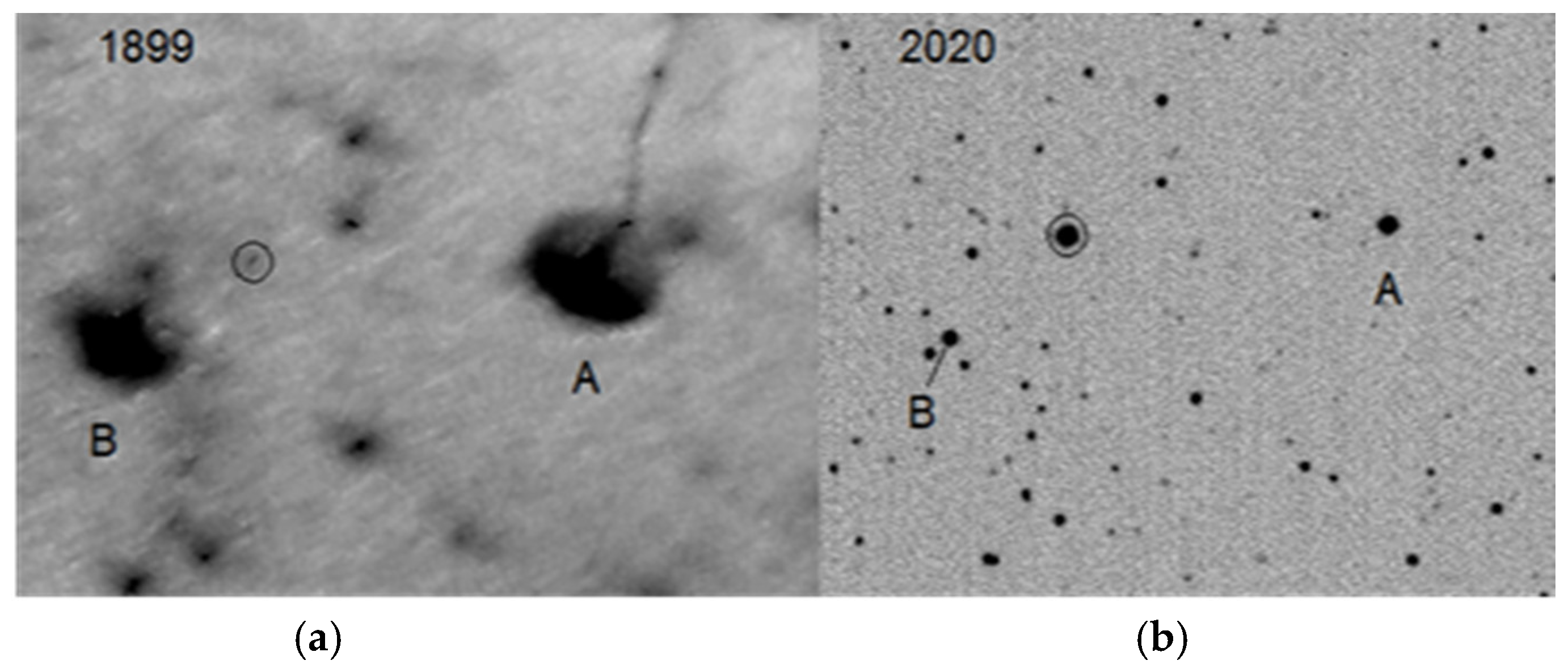
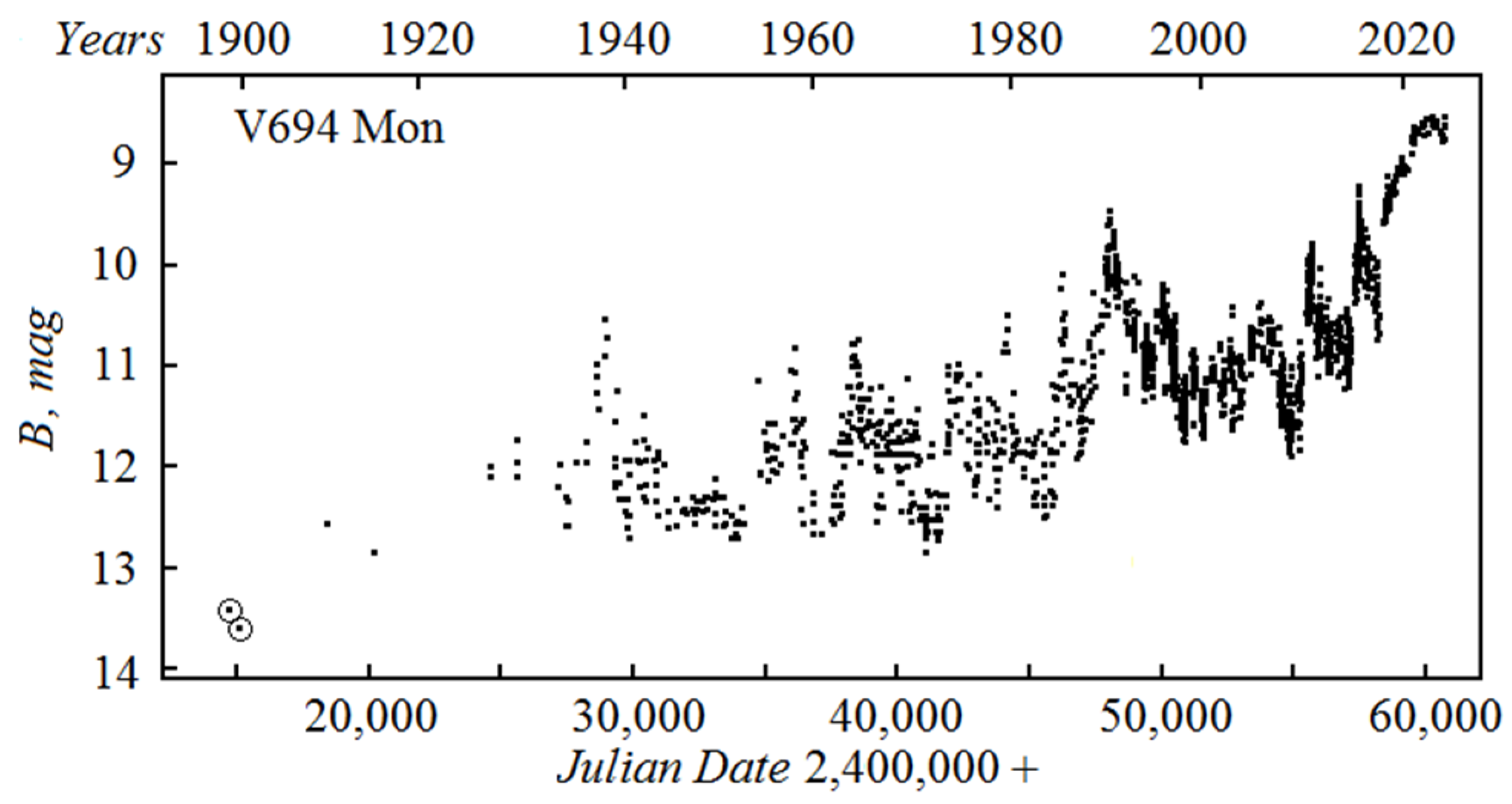
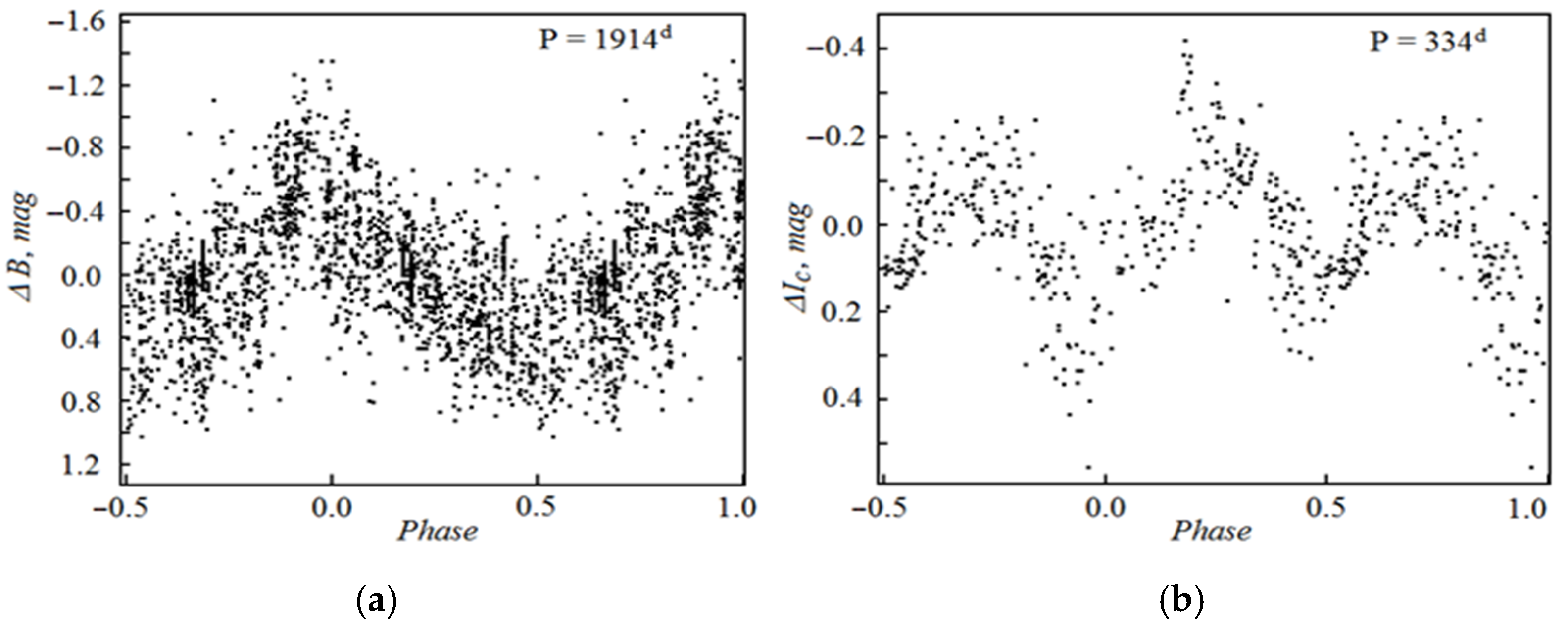
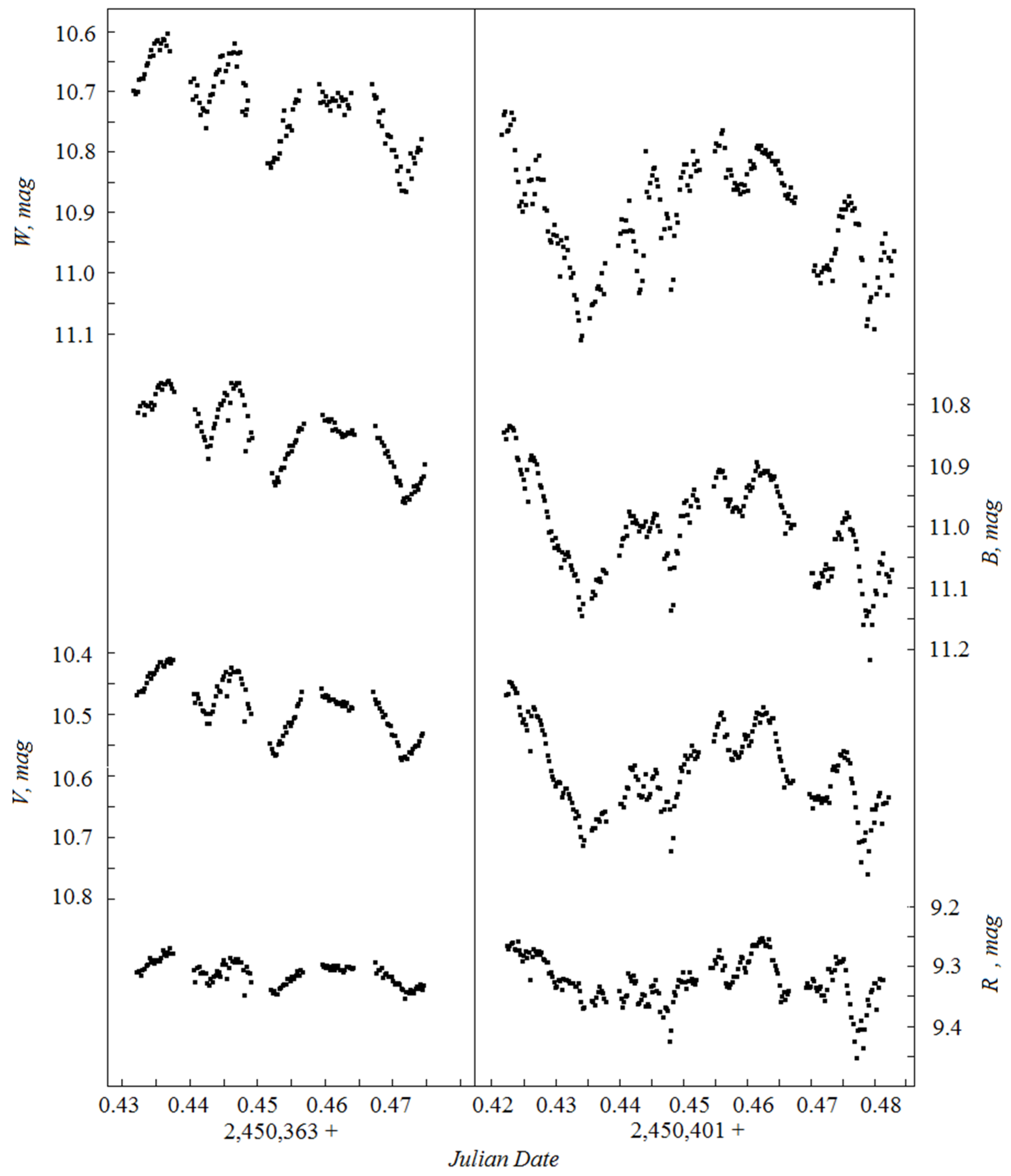
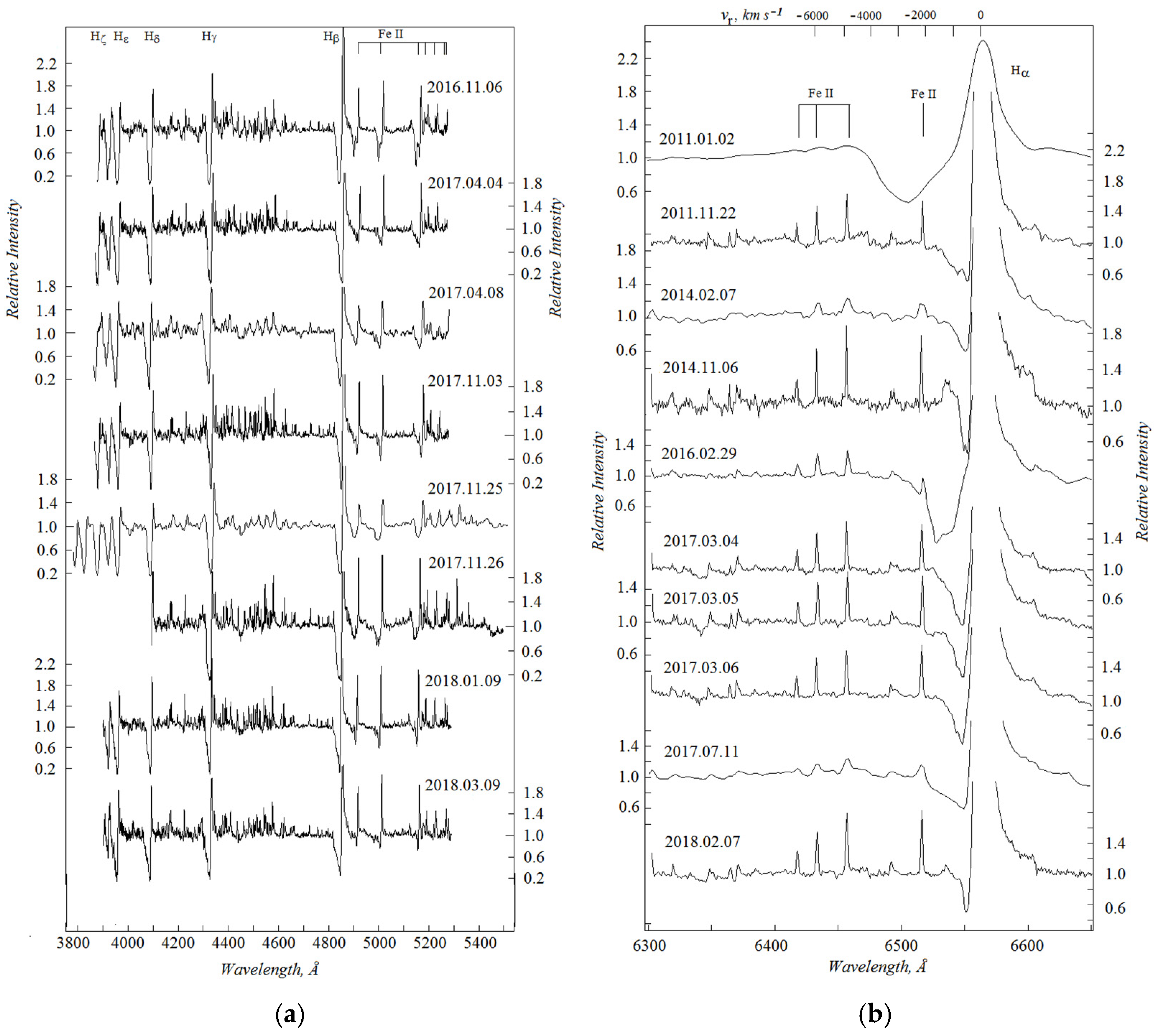
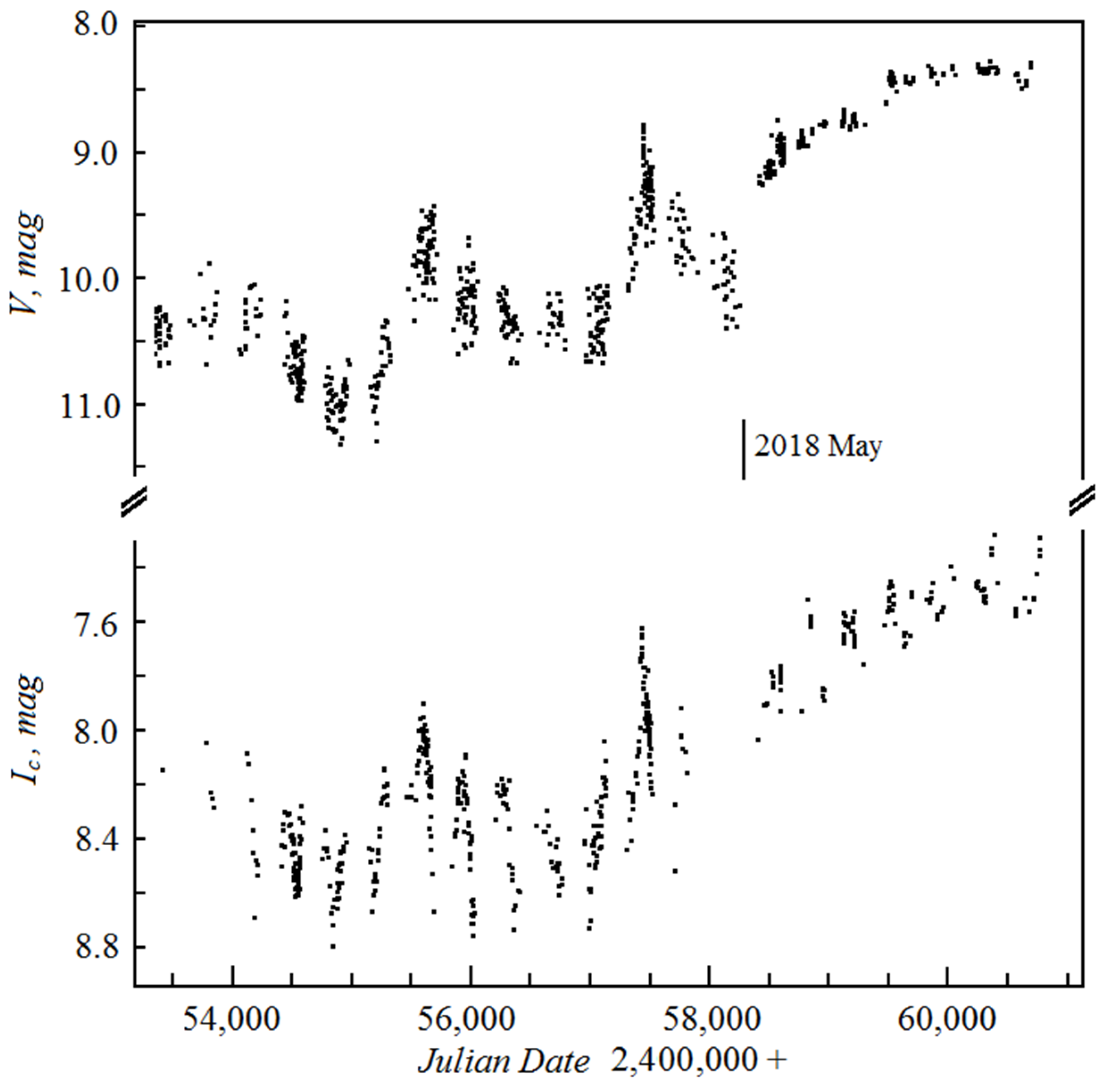

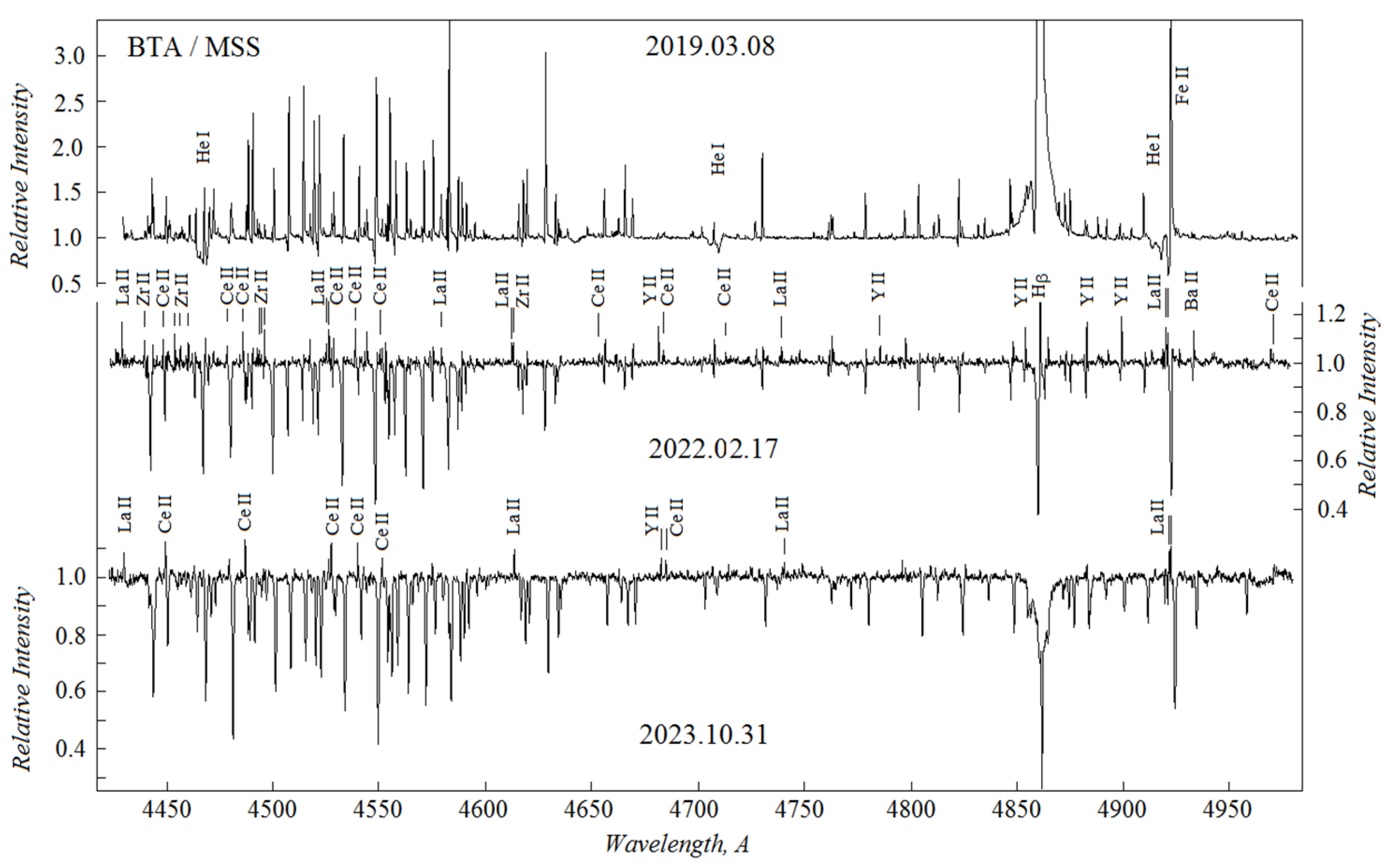

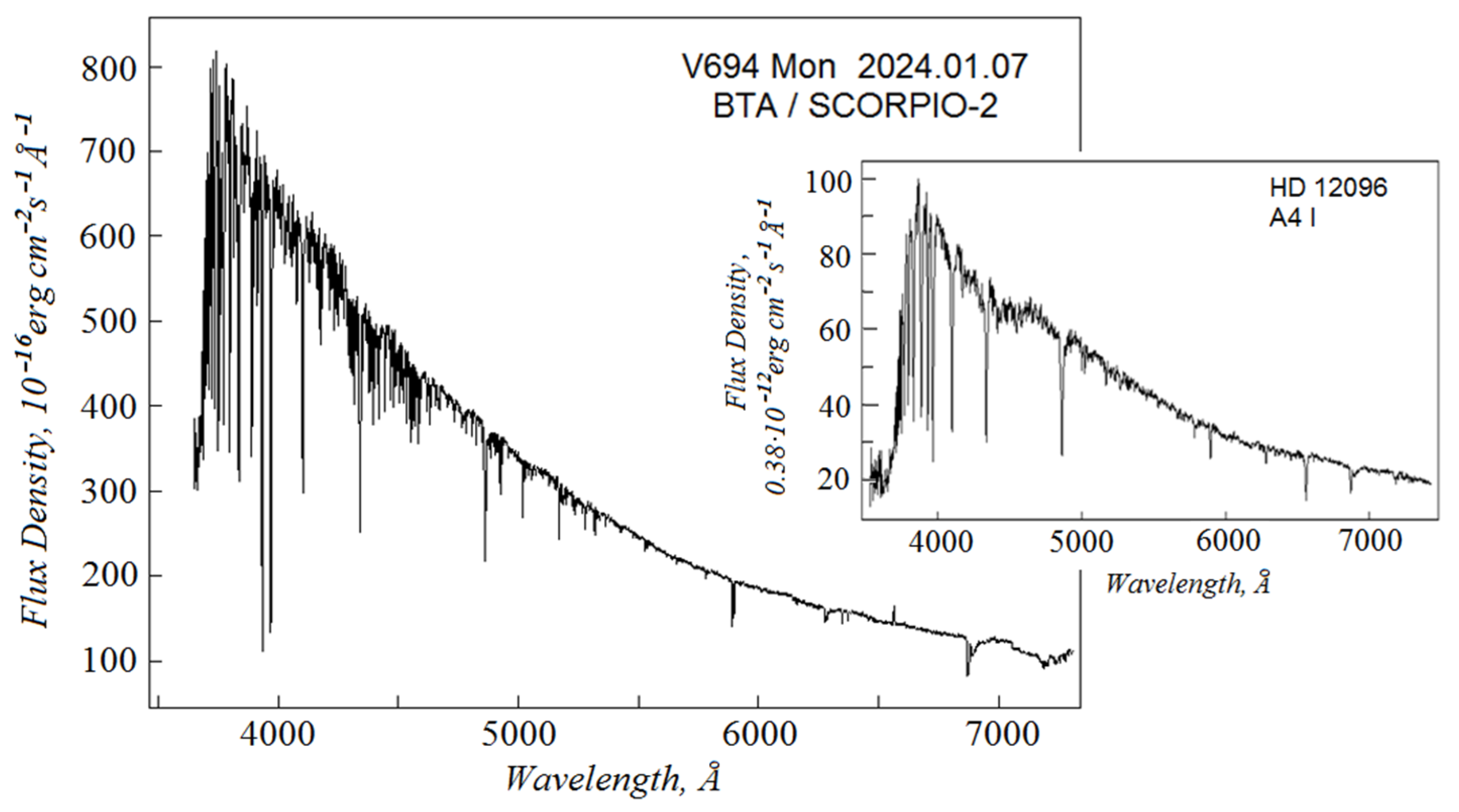
Disclaimer/Publisher’s Note: The statements, opinions and data contained in all publications are solely those of the individual author(s) and contributor(s) and not of MDPI and/or the editor(s). MDPI and/or the editor(s) disclaim responsibility for any injury to people or property resulting from any ideas, methods, instructions or products referred to in the content. |
© 2025 by the authors. Licensee MDPI, Basel, Switzerland. This article is an open access article distributed under the terms and conditions of the Creative Commons Attribution (CC BY) license (https://creativecommons.org/licenses/by/4.0/).
Share and Cite
Goranskij, V.P.; Barsukova, E.A.; Burenkov, A.N.; Metlova, N.V.; Zharova, A.V.; Yakunin, I.A. V694 Mon: A Recent Event of Mass Transfer in the Dynamical Mode. Galaxies 2025, 13, 59. https://doi.org/10.3390/galaxies13030059
Goranskij VP, Barsukova EA, Burenkov AN, Metlova NV, Zharova AV, Yakunin IA. V694 Mon: A Recent Event of Mass Transfer in the Dynamical Mode. Galaxies. 2025; 13(3):59. https://doi.org/10.3390/galaxies13030059
Chicago/Turabian StyleGoranskij, Vitaly P., Elena A. Barsukova, Aleksandr N. Burenkov, Natalia V. Metlova, Alla V. Zharova, and Ilya A. Yakunin. 2025. "V694 Mon: A Recent Event of Mass Transfer in the Dynamical Mode" Galaxies 13, no. 3: 59. https://doi.org/10.3390/galaxies13030059
APA StyleGoranskij, V. P., Barsukova, E. A., Burenkov, A. N., Metlova, N. V., Zharova, A. V., & Yakunin, I. A. (2025). V694 Mon: A Recent Event of Mass Transfer in the Dynamical Mode. Galaxies, 13(3), 59. https://doi.org/10.3390/galaxies13030059







